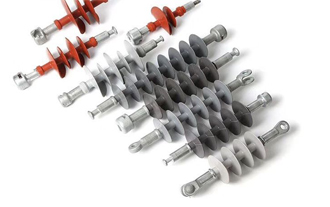1 Type of insulator
Power line distribution hardware fitting supplier to share with you: the wires of overhead power lines are connected and fixed on the pole tower by insulators and metal fittings. Insulators used for the insulation of conductors and towers must not only withstand the working voltage and overvoltages during operation, but also withstand the effects of mechanical forces and temperature changes and the surrounding environment. Therefore, the insulators must be in good condition. Insulation performance and certain mechanical strength. Generally, the surface of the insulator is corrugated. This is because: first, it can increase the leakage distance of insulators (also known as creepage distance), and each wave twist can also play a role in blocking the arc; second, when it rains, the sewage flowing from the insulator will not directly It flows from the upper part to the lower part of the insulator to prevent the formation of a sewage column and cause a short-circuit accident. It plays a role in blocking the flow of sewage. It is evenly attached to the insulator, which improves the anti-fouling ability of the insulator to a certain extent. There are many types of insulators for overhead power lines. He can classify them according to the structure type, insulation medium, connection method and bearing capacity of the insulator.

Pin Insulator With Spindle
Structure type: disc insulator, rod insulator
Insulation medium: porcelain insulator, glass insulator, semiconductor glaze insulator, composite insulator
Connection method: ball insulator, slot insulator
Installation field environment, indoor insulator, outdoor insulator.
Carrying capacity: 5kN, 10kN, 12kN, 40kN, 60kN, 70kN, 100kN, 120kN, 160kN, 210kN, 300kN, 420kN, 550kN ...
Pin type insulators are mainly used to support wires for straight rods and angle rods with smaller angles. They are divided into high voltage and low voltage. Pin-type porcelain insulators and pin-type composite insulators are divided according to materials.
Insulator model description:
P-ordinary pin insulator;
PQ1-reinforced insulation type 1 (medium pollution) pin type insulator;
PQ2——Reinforced Insulation Type 2 (Extra Heavy Duty Type) Pin Insulators;
FPQ—— stands for composite pin type anti-fouling insulator;
B——The parts above the side grooves of the porcelain, except the firing surface, are all covered with semiconductor glaze;
T——with feet, iron shoulder;
M——long feet;
L——Without feet, porcelain parts are threaded with feet;
LT——With feet, porcelain parts and feet are threadedly connected, iron arms;
The number 10 after the dash indicates the rated voltage of 10kV; the numbers 16 and 20 after T indicate the lower thread diameter.
Such as:
P-15T16, P is a common pin insulator, 15 is a rated voltage of 15kV, and 16 is a diameter of the lower end thread of 16mm.
FPQ4-10 / 3T20, F means compound, P means pin type, Q means anti-fouling type, 4 means anti-fouling grade, 10 means rated voltage 10kV, 3 means rated bending load 3kN, 20 means lower thread diameter 20mm.
The shape of the common pin insulator is shown in the figure below. The supporting steel feet of the pin insulator with spindle with a main shaft are poured into the porcelain with concrete, forming a "porcelain-clad iron" inner pouring structure.
+86 319 878 9350
+86 156 1304 7999
+86 319 878 9350
NanYan, DongHuan Road, Shahe, Hebei China
Copyright © Hebei Yipeng Line Equipment Co., Ltd. All Rights Reserved. | Sitemap Powered By 
